Abstract
Seasonal quantification of a crop’s evapotranspiration (ET) and water footprint (WF) is essential for sustainable agriculture. Therefore, this study was conducted to estimate the ET and WF of an irrigated potato crop using satellite imagery of Landsat and Sentinel-2 sensors. The Simplified Surface Energy Balance (SSEB) algorithm was used to evaluate the crop water use (ETa) for potato fields belonging to the Saudi Agricultural Development Company, located in the Wadi-Ad-Dawasir region, Saudi Arabia. Normalized difference vegetation index (NDVI), soil-adjusted vegetation index (SAVI), and land surface temperature (LSD) were computed for Landsat and Sentinel-2 datasets, which were used as inputs for mapping the potato tuber yield and, subsequently, the WF. The results indicated that the NDVI showed the best accuracy for the prediction of the potato tuber yield (R2 = 0.72, P > F = 0.021) followed by the SAVI (R2 = 0.64, P > F = 0.018), compared to the field harvested actual yield (YA). A comparison between the satellite-based ETa and the actual amount of water applied (WA) for irrigation showed a good correlation (R2 = 0.89, RMSE = 4.4%, MBE = 12.9%). The WF of the potatoes in the study area was estimated at values between 475 and 357 m3 t−1 for the early (September–December) and late (December–April) growing periods, respectively. A major portion (99.2%) of the WF was accounted for from irrigation with variations of 18.5% and 3.5% for early- and late-planted potatoes, respectively, compared to the baseline (crop planted in season). In conclusion, the results showed the possibility of satisfactorily estimating the WF using the SSEB algorithm by integrating the Landsat-8 and Sentinel-2 datasets. In general, the high rates of ET in the early planting season led to higher WF values compared to the in-season and late planting dates; this will help in selecting suitable planting dates for potato crops in the study area and areas with similar environments, which enhances the opportunities for sustainable management of irrigation water.
1. Introduction
Population growth and rapid changes in people’s lifestyles have led to a significant increase in the demand for water all over the world, and this requires paying special attention to the quantities of water used in irrigating agricultural crops and those used in associated industries [1]. The water footprint (WF), which was introduced to assess irrigation efficiency [2], is defined as the ratio of the volume of water used (m3 ha−1) to the crop yield (t ha−1) [3,4,5]. The scarcity of freshwater resources and harsh environmental conditions have forced Saudi Arabia to make greater efforts to adopt sustainable agricultural practices [6]. In this regard, the importance of using effective agricultural methods in estimating the water requirements of different crops has emerged as an essential element for improving decision-making strategies relating to agricultural production and the consequent positives in the area of food security [7].
Multidate remotely sensed images and mapping algorithms has become a useful tool for the precise administration of irrigation water and scheduling, as they provide comprehensive data of agricultural fields at appropriate time intervals that help in estimating crop water consumption during the different growth stages of crops [8,9,10]. The use of various applications of remote sensing and GIS in irrigation management practices has been extensively studied by many researchers, as several protocols used for estimating crop biophysical parameters under different environmental conditions have been developed and tested [9,11,12,13]. Remote sensing applications are used in agriculture to estimate biomass and yield, monitor vegetation activity and drought stress, and map agricultural land uses, as well as a wide range of uses in precision agriculture and management of irrigation water [14,15,16].
Advancements in remote sensing techniques and algorithms have been proven to achieve estimates of crop yield, actual evapotranspiration (ETa), crop water use, and water footprint with the use of multispectral data, such as MODIS, Landsat, Sentinel, IRS, VIIRS, AVHRR, etc. [17]. The use of time-series data with appropriate temporal and spatial resolution effectively contributes to the monitoring of crop health, phenology, vigor, surface temperature, and associated factors in the mapping of ETa, crop water use, and water footprints (WF) as per the length of the crop growth period [18]. On the other hand, crop water-use mapping is also achieved with the integration of multispectral images from multiple sensors [19,20].
The WF (m3 t−1) of a certain crop is calculated by dividing the total volume of the applied irrigation water (m3 ha−1) by the quantity of the production (t ha−1) [21,22,23,24]. As per the source of the irrigation water, the WF is quantified as a green component (WFgreen), where the irrigation water for crops is the rainwater resource. Regarding the blue component of WFblue, the source of irrigation is groundwater. The two components WFgreen and WFblue together indicate the consumptive water footprint (WFB+G) of a crop in a given season, while the WFgrey indicates the amount of water used to absorb the pollutants from the used chemicals as well as the quality standards of irrigation water [25].
Advancements in remote-sensing image analysis techniques have proven effective in accurate estimation of ETa through several algorithms that have been successfully used and reported in the literature [26]. The most widely used algorithms include the SEBAL (Surface Energy Balance Algorithm over Land), the METRIC (Mapping Evapotranspiration with Internalized Calibration), the SEBS (Surface Energy Balance System), the SAFER (Simple Algorithm For Evapotranspiration Retrieving), the SSEB (Simplified Surface Energy Balance), the SSEBI (Simplified Surface Energy Balance Index), the TSM (Two-Source Model), and the TSTIM (Two-Source Time-Integrated Model), etc. [27,28]. The SSEB algorithm is widely used for estimating the ETa of agricultural fields due to its simplicity, its dependence on minimum data, and its ease of implementation without affecting the final accuracy [29,30]. Many previous studies on WF in crop production focused on the use of either global scales [22,31] or local scales [32,33,34,35,36,37,38]. The crop coefficient (Kc) is a key factor in determining ETa based on the reference ET (ETo) of a certain crop [39]. Several studies have successfully substituted Kc values with the fraction of ET (ETf) in ETa mapping [40,41,42].
Understanding the time-based and spatial variations in crop water demand at a regional level is essential for better management of available water resources by formulating reliable irrigation schedules [43]. Irrigation management mainly depends on planting dates and respective evapotranspiration rates, which in turn vary in the volume of irrigation water application to the crops for early- and late-planted potatoes, compared to the baseline (crop planted in season). Therefore, this study aimed to estimate the WF of a potato crop grown in three different planting periods, namely early, on-season, and late planting, in the arid climates of Wadi-Ad-Dawasir, Saudi Arabia, using the SSEB algorithm by integrating the Landsat-8 and Sentinel-2 datasets. The specific objectives included the following: (i) estimating the ET fraction (ETf) of the potato crop, (ii) understanding the relationship between the obtained ETf and the FAO-crop coefficient (Kc) values for the replacement of Kc with ETf in ETa mapping using the SSEB algorithm, and (iii) mapping and evaluating the WF of the potato crop against the field-measured actual yield (YA) and actual applied water (WA) for better management of water resources by selecting the appropriate planting dates.
2. Materials and Methods
2.1. Study Site
The experimental work has been conducted on six agricultural fields in a commercial farm belonging to the Saudi Agricultural Development Company, located in the Wadi-Ad-Dawasir area in Riyadh province, Saudi Arabia, between latitudes of 19.90° and 20.33° N and longitudes of 44.81° and 44.95° E (Figure 1). The soil in the study farm is characterized as sandy loam, and the major cultivated crops are potato, wheat, melon, and other vegetable crops.
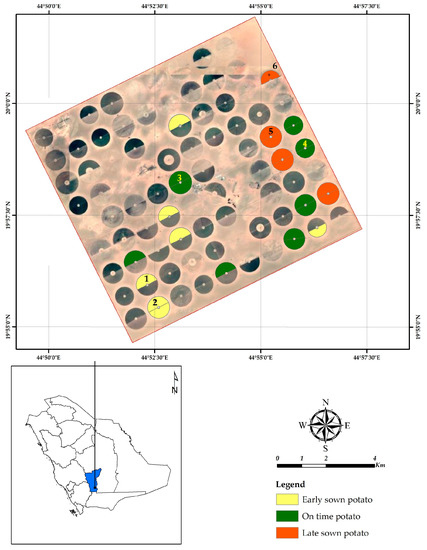
Figure 1.
Geographic location of the experimental farm, INMA, Wadi-Ad-Dawasir, Saudi Arabia. The fields indicated with black and grey colors are cultivated with crops other than potatoes. The experimental fields are numbered from 1 to 6.
The climatic conditions of the study area are characterized by hot summers with an average daily maximum temperature of 49 °C and cold winters with an average daily minimum temperature of 7 °C. The relative humidity is normally stable at 24%, while the daytime is, on average, around 11 h. The average wind speed is 13 km h−1; however, it can reach as high as 46 km h−1 during thunderstorms, with an average annual rainfall of 37.6 mm [44,45]. The major cultivated crops in the study farm are potatoes, corn/maize, durum wheat, watermelon, and fodder (alfalfa), due to sparse and low rainfall with arid climates and higher evapotranspiration rates which exceed rainfall. Hence, supply of irrigation water is mandatory to achieve the crop evaporative demands (Figure 2). Most of the irrigation water (92%) is extracted from groundwater resources. During the study, the potatoes are grown under full irrigation.
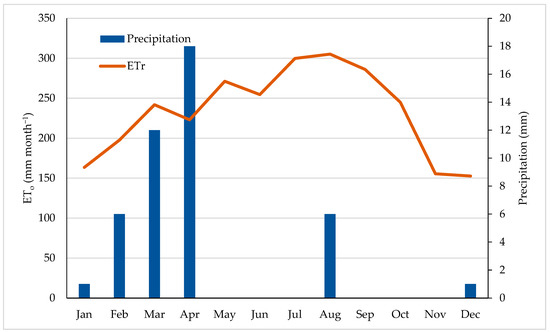
Figure 2.
Monthly mean precipitation (P) and reference evapotranspiration (ETo) in the experimental farm, Wadi-Ad-Dawasir, Saudi Arabia. Source: INMA Farm 2010–2020.
2.2. Sampling and Field Data
The experimental farm (INMA commercial farm) contains 90 fields irrigated by center-pivot systems, of which 17 fields were cultivated with a potato crop (Figure 1). The potato fields were cultivated in three planting periods, namely early planting, in-season planting, and late planting (Table 1). Of the 17 potato fields, 6 fields (2 experimental fields per planting date/period) were allocated for sampling, and a total of 120 sampling locations (30 from each field) were randomly identified as permanent plots, with the help of a handheld GNSS receiver (GeoXH6000, Trimble, Westminster, CO, USA). Growth/phenology stages and biophysical parameters (LAI, canopy surface temperature) were recorded from emergence to harvest. Periodic ground truth data recorded during the crop growth included phenology stages and biophysical properties such as plant height, leaf area index (LAI), chlorophyll content (SPAD), NDVI and canopy temperature. All samples were divided into three groups as follows: (i) training data (50%) for developing classification models, (ii) validation data (25%) for hyper parameter tuning, and (iii) test data (25%) for evaluation of classification/prediction map accuracies. Subsequently, the generated models were applied to all the 17 potato cultivated fields. Soil samples were collected at a depth of 0 to 10 cm from the soil surface and then analyzed using standard laboratory methods to determine soil bulk density (g m−3), water retaining capacity (%), and wilting point (%). LAI measurements were performed using the Plant Canopy Analyzer (PCA-2200, Li-cor Biosciences, USA). The information on agricultural practices, irrigation schedules, volume of water applied to the fields, and crop yield data was obtained from the records of the experimental farm. Meteorological data were collected from the weather station installed in the experimental farms. Field-based crop water use was assessed based on the soil water budget method.

Table 1.
Details of experimental fields.
2.2.1. Potato Yield
Yield samples were collected from selected potato fields by harvesting an area of 2.5 square meters from each of the randomly specified sampling locations. The net weights of the potato yield samples were converted to a standard yield unit (t ha−1) after excluding damaged, small, or irregularly shaped potato tubers.
2.2.2. Irrigation Water Demand—CROPWAT Method
CROPWAT is a decision support tool developed by the Land and Water Development Division of the FAO. CROPWAT (ver. 8.0) for windows is a computer program for the calculation of crop water requirements based on soil, climate, and crop data. In addition, the program facilitates the development of irrigation schedules for different management practices. The crop water requirement (WA) and irrigation schedules were developed using the CROPWAT program, as described in Allen et al. [46]. To match the volume of irrigation water with crop water requirement, readily available water for the plants was assessed.
2.3. Satellite Data and Image Analysis
Free-of-cost time series satellite images of Sentinel-2 (A/B) and Landsat 8/9 (L8/L9) were downloaded from the United States Geological Survey (USGS) facility (https://earthexplorer.usgs.gov/ (accessed on 20 February 2023)) coinciding with the growth period of the potato crop according to the presented details in Table 2. The downloaded images were subjected to atmospheric correction for clouds and shadows and then used to calculate vegetation indices (NDVI, SAVI, LAI), land surface temperature (LST), vegetation indices, canopy temperature, potato yield, evapotranspiration (ET), and water footprint (WF) according to potato planting periods, using the QGIS (version 3.28) and SNAP (Version 9.0.0) and ESRI ArcGIS (Version 10.7) software programs. The datasets were standardized to the projected coordinate system of WGS84/UTM zone 38 N, and then regions of the experimental fields (region of interest—ROI) were extracted.

Table 2.
Details of Sentinel-2 and Landsat-8 data used to map the water footprint (WF) of potato in Wadi-Ad-Dawasir, Saudi Arabia.
2.4. Mapping of Potato Water Footprint
Satellite images of Sentinel-2 (A/B) and Landsat 8/9 (L8/L9) were acquired. The water footprint (WF) of potato crop was determined (Equation (1)) by dividing the total volume of water use (m3 season−1) by the quantity of the production (t ha−1), i.e., potato yield [21,22,23,24]. Both the green and blue WF components were assessed as per potato planting periods.
where water footprint (WF) is in m3 t−1, crop water use (m3 ha−1) is derived from satellite images based on the SSEB algorithm, and the crop yield (t ha−1) is predicted using potato yield prediction models developed by Al-Gaadi et al. [47] in the same experimental farm.
2.4.1. Crop Water Use
The SSEB algorithm, proposed by Senay et al. [27], was adopted to estimate the actual evapotranspiration (ETa), which was considered as the CWU, as illustrated in the systematic flow presented in Figure 3. The ET fraction (ETf) was computed to substitute the crop coefficient (Kc) value in calculating the ETc (Equation (2)).
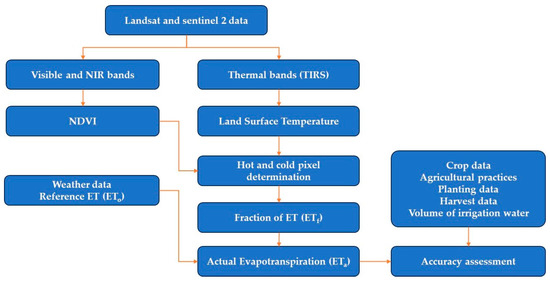
Figure 3.
Flowchart illustrating the steps for estimating the daily evapotranspiration (ET) using the SSEB algorithm.
Initially, the land surface temperature (LST) was calculated using the TIR bands of Landsat-8/9. The ETf, was calculated from the LST and vegetation indices layers [48,49]. Vegetation indices (NDVI, SAVI, and LAI) were calculated from Sentinel-2 data. Then, the daily ET was calculated using a methodology similar to the classic method of the crop coefficient (Kc), using Equation (2) provided by Allen et al. [46]. Equation (3) confirms that the ETf is similar to the Kc [40,50]. Since Sentinel-2 does not contain thermal data, the SSEB model cannot be applied for ET mapping alone [19]., the ratios of ETf to NDVI of both Landsat and Sentinel-2 were integrated as described in Singh et al. [19]. The ETf of each pixel was assessed by combining the cold (LSTCP) and hot (LSTHP) pixels of the studied potato fields. Then, the obtained ETf of individual pixels was used to calculate the ETa for each field. The reference ET (ETo) was calculated according to the FAO-56 Penman–Monteith formula (Equation (4)).
where
LSTHP = the average temperature of three hot pixels selected from each scene;
LST = the land surface temperature in a composite scene;
LSTCP = the average of three cold pixels selected in each Landsat scene.
where ETo is the reference evapotranspiration (mm d−1), Rn is the net radiation at the crop surface (MJ m−2 d−1), G is the soil heat flux density (MJ m−2 day−1), T is the daily air temperature at 2 m height (°C), u2 is the wind speed at 2 m height (m s−1), es is the saturation vapor pressure (kPa), ea is the actual vapor pressure (kPa), es–ea is the saturation vapor pressure deficit (kPa), Δ is the slope of the vapor pressure curve (kPa °C−1), and γ is the psychrometric constant (kPa °C−1).
Subsequently, the blue (CWUblue) and green (CWUgreen) components of the CWU were calculated as per Equations (5) and (6).
where ETgreen is the green water evapotranspiration, and ETblue is the blue water evapotranspiration from day one (d = 1) until the specified length of the growth period (lgp). The factor 10 is to convert water depths in millimeters into water volumes per unit area (m3 ha−1).
2.4.2. Water Footprint
The crop water footprint (WF, m3t−1) was determined as the sum of the blue (WFblue) and green (WFgreen) components of the WF, as shown in Equation (7) and provided by Hoekstra et al. [23]. The CWU (m3 ha−1) for each component was calculated using Equations (8) and (9) according to Aldaya et al. [51].
Finally, the green and the blue WF of potato crop was obtained as per Equations (8) and (9) as described in Hoekstra et al. [23]. Both the WFblue and WFgreen components of a crop’s WF was computed by dividing the CWU by potato yield (CP) (t ha−1).
where CWUgreen and CWUblue are the green (rainfall) and blue (surface and groundwater) water used in irrigating the crop.
2.5. Water Footprint Based on Field Data
For accuracy assessment, field data-based WF was computed using the collected field observations and agri-meteorological parameters. The blue WF, which represents the volume of irrigation water applied to the crop, was calculated using Equation (10) according to Scarpare et al. [52].
where WFMblue (m3 t−1) is the blue WF estimated from measured irrigation data, Yf is the potato tuber yield, Ir is the irrigation water applied during the growth period (mm), DP is the deep percolation water leaving the root zone (mm), and RO is surface runoff water. Since it is difficult to measure the losses from such large fields, an average irrigation efficiency of 70% was considered in the center pivot irrigation systems [53] to account for the losses due to surface runoff and deep percolation.
2.6. Statistical Analysis
The crop yield and WF estimated based on remote sensing approaches were assessed using selected accuracy indicators such as the root mean square error (RMSE), mean bias error (MBE), and co-efficient of regression (R2). The statistical analysis was performed using the SPSS (Ver.20) software program.
3. Results
The basic climatic datasets required for the CROPWAT model, such as the average values of monthly rainfall, temperature, wind velocity, water vapor content, and day-light duration, was obtained from the weather station installed in the experimental farm. The average daily maximum air temperature ranged between 37 °C in May and 47 °C in August, while the average daily minimum temperature ranged between 14.2 °C in January and 38 °C in August, with an average daily temperature of 34 °C. The maximum (22.6%) water vapor content was observed in the period from November to February, and the minimum (6.9%) values were found in the period from May to September. The lowest levels of the wind speed in the study area were in October, and the highest were in July. The duration of sunshine hours ranged between 9.5 and 13.5 h, with an average daily sunshine of about 11 h. The effective rainfall was calculated using the CROPWAT model. Similarly, the reference evapotranspiration was calculated using the Penman–Monteith method (Equation (4)) according to Allen et al. [46]. The monthly values of evapotranspiration are presented in Table 3. The recorded rainfall across the experimental period was 68 mm, most of which occurred during the period between February and April. The reference evapotranspiration (ETr) reached its maximum (12.3 mm d−1) in September. The average daily ETo was found to be 8.7 mm d−1, 8.2 mm d−1, and 7.7 mm d−1 for early, on-season, and late plantings of potato seasons, respectively.

Table 3.
Reference ET (ETo) of experimental farm as per the potato planting periods.
The total yield of potato tubers in the experimental fields ranged between 51.1 t ha−1 and 55.4 t ha−1. An average commercial harvest was estimated at 45.2 t ha−1 for the on-season crop, followed by early- (39.6 t ha−1) and late-planted (34.4 t ha−1) crops. Based on the actual yield (YF) data and SAVI, the predicted yield (YP) map was generated (Figure 4) with an accuracy of 10.9 ± 2 (Table 4). There is a variation in the predicted yield, where the in-season potato tuber yield was 83% of the actual yield, whereas the yield of the early- and late-planted potato crops was estimated at 71% and 69% of the actual yield, respectively. Linear regression analysis was performed between the predicted and actual field-measured potato yield, and a significant correlation was found with R2 values ranging between 0.63 and 0.71 and p values ranging between 0.020 and 0.036.
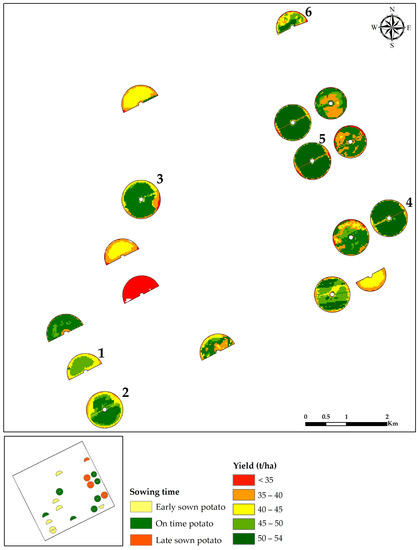
Figure 4.
Potato yield maps of studied fields. The sample fields are numbered from 1 to 6.

Table 4.
Field-measured actual (YF) and Sentinel-2 satellite-predicted (YP) potato yields (t ha−1).
The crop water use of the studied potato planting periods varies between 1237 mm and 1814 mm for late- and early-planting periods (Figure 5). An approximately 17.3% increase and a 20% reduction in applied irrigation water for the early- and late-planting period, respectively, was noticed, compared to on-season plantation. The SSEB-based ETa also showed a similar trend (Table 5).
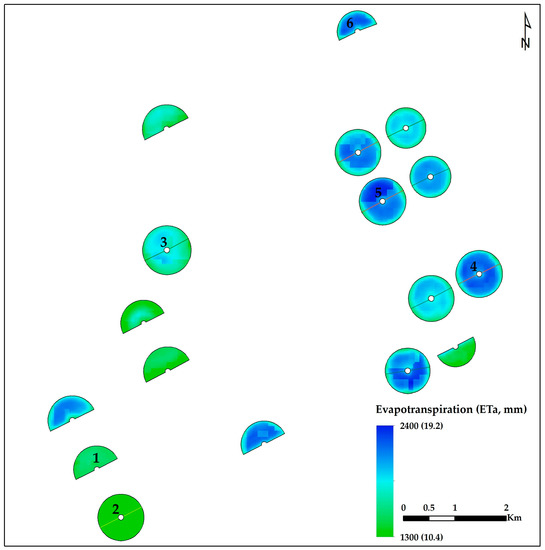
Figure 5.
Crop water use (mm) of studied potato fields. The sample fields are numbered from 1 to 6.

Table 5.
Field-estimated and satellite image-predicted crop productivity *, crop water use, and water footprint of potato crop.
The WFG+B of potato fields based on plantation period varied between 357 m3 t−1 for the on-season and 475 m3 t−1 for the early sowing period (Figure 6). This accounts for a 24.5% (early) and a 9% (late) increase in water consumed for the production of potato compared to the on-season plantation period.
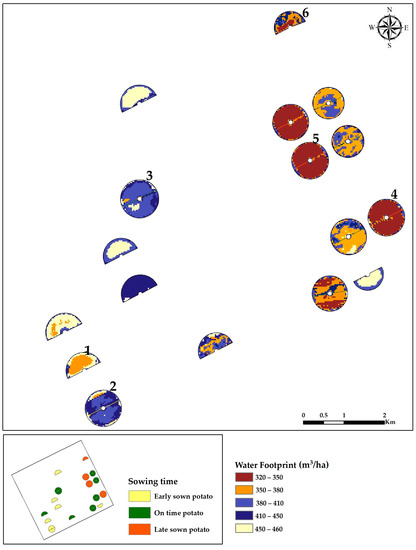
Figure 6.
Potato water footprint map of studied fields. The sample fields are numbered from 1 to 6.
4. Discussion
The water footprint (WF) of potato crop was estimated with the use of free-of-cost satellite images, viewed by Sentinel-2 and Landsat satellites. The potato yield was predicted from S2 satellite datasets. The predicted yield, crop water use (ETa), and WF were subjected to linear regression analysis against the actual field measurements. All the studied parameters showed significant correlations with R2 values of 0.67–0.69 (Yield), 0.78–0.81 (CWU), and 0.74–0.76 (WF), as presented in Table 6.

Table 6.
Accuracy assessment of generated maps and field data.
On the other hand, the CWU (ETa) was successfully determined using the SSEB algorithm with an accuracy of 89.2%. A variation of 10.6% and 12.6% was noticed for CROPWAT and the actual amount of water applied to the crop, respectively. The average total WF of potato was 684.6 m3 t−1, in which the green and blue WF components were represented by approximately 8% and 92%, respectively. A comparison between the values of the blue WF, which is the major component of the WF in this study, estimated by the SSEB and those calculated on the basis of actual field data showed good agreement (MSE = 8.4%, and MBE = 12.9%). The effect of planting date on the WF estimates was also investigated in this study, where slight variations of 3.5% (late planting) to 18.5% (early planting) for a deviation of about two months from the optimum recommended planting dates were noticed. It can be concluded that estimation of the WF could be performed satisfactorily using the SSEB model for better irrigation management.
Regarding the crop growth stage, ETf values of the potato crop were assessed against the Kc values (Figure 7). In the initial stage, ETf values are low (0.48) for all planting periods. During the development stage, it reached a peak value of 2.1, and decreased to 0.7 at mature stages (Figure 7). The results are in agreement with published studies, such as de Sousa Junior et al. [54]. Badr et al. [55] developed Kc maps based on NDVI and TIR bands of Landsat imagery for wheat, potato, and sugar beet crops to understand the spatial and temporal distribution of Kc value in a field. Jayanthi et al. [56] and Kumar et al. [57] standardized the SSEB-based ETc estimation as a promising method. The obtained WF values of the potato crop were compared with the published data (Table 7). The WFa maps prepared at the field-scale level with a resolution of 10 m are useful in quantifying the actual water requirement corresponding to the different crop growth stages.
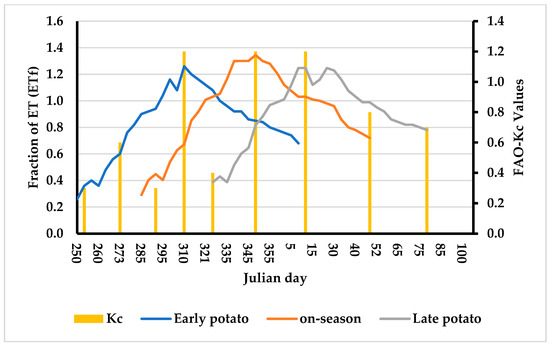
Figure 7.
The comparison between potato FAO Kc and NDVI-based potato Kc.

Table 7.
Water footprint (WF) of potato crops compared to published data.
The SSEB-based ETf values of the studied potato fields ranged between 0.3 and 1.0, which were found to coincide with the FAO-recommended Kc values. As an example, the Kc value at the initial crop growth stage (0.4 to 0.5) nearly matched the ETf values of 0.30 to 0.42, whereas during the mid-stage of the crop growth, the ETf reached a peak value of 1.0, which is slightly lower by 0.2 compared to the FAO-recommended value (1.2). A significant linear relationship (R2 = 0.96) was observed between the ETf and Kc values, which proves the effectiveness of using the predicted ETf and, subsequently, the WF of the potato crop.
5. Conclusions
The Simplified Surface Energy Balance (SSEB) algorithm was successfully used to evaluate the crop water use (ETa) for potato fields belonging to the Saudi Agricultural Development Company, Wadi-Ad-Dawasir, Saudi Arabia. NDVI and LST were computed by integrating Landsat and Sentinel-2 datasets, which in turn were used for the ETa and WF mapping of potato crops. A comparison between satellite-based ETa and field-based estimates showed a good correlation (R2 = 0.89, RMSE = 4.4%, and MBE = 12.9%). The WF of potato in the study area was estimated at values between 475 and 357 m3 t−1 for the early (September–December) and late (December–April) growing periods, respectively. Due to sparse and low rainfall, a major portion (99.2%) of the WF was accounted for by irrigation, with variations of 18.5% and 3.5% for early- and late-planted potatoes, respectively, compared to the baseline (crop planted in season). These results will help in achieving sustainable management of available groundwater resources by selecting suitable planting dates for potato crops in the study area and associated areas.
Author Contributions
Conceptualization, K.A.A.-G. and R.M.; methodology, K.A.A.-G., R.M. and E.T.; software, R.M. and S.E.-H.; validation, K.A.A.-G. and S.A.M.; formal analysis, R.M.; investigation, R.M., E.T. and S.E.-H.; resources, K.A.A.-G. and S.A.M.; data curation, E.T.; writing—original draft preparation, R.M., E.T. and S.E.-H.; writing—review and editing, K.A.A.-G. and R.M.; visualization, E.T.; supervision, K.A.A.-G.; project administration, R.M.; funding acquisition, R.M. All authors have read and agreed to the published version of the manuscript.
Funding
This work was funded by the National Plan for Science, Technology, and Innovation (NSTIP) or the MAARIFAH/GRANTS program, King Abdulaziz City for Science and Technology, Kingdom of Saudi Arabia for funding this study through the NSTIP strategic technologies programs, under Grant Number 2-17-04-001-0016.
Institutional Review Board Statement
Not applicable.
Informed Consent Statement
Not applicable.
Data Availability Statement
Not applicable.
Acknowledgments
The authors are grateful to the National Plan for Science, Technology, and Innovation (NSTIP) unit, and the MAARIFAH/GRANTS program, King Abdulaziz City for Science and Technology, Kingdom of Saudi Arabia for funding. The authors also acknowledge the assistance of INMA Farm’s staff during the fieldwork. The Deanship of Scientific Research, King Saud University, is greatly appreciated for providing facilities for this study.
Conflicts of Interest
The authors declare no conflict of interest.
Abbreviations
| Acronym/Variable | Explanation |
| CP | Crop productivity |
| CWU | Crop water use |
| CWUBlue | Crop water use—blue component |
| CWUGreen | Crop water use—green component |
| ET | Evapotranspiration |
| ETa | Actual evapotranspiration |
| ETc | Crop evapotranspiration |
| ETf | Fraction of Evapotranspiration |
| ETo | Reference Evapotranspiration |
| Kc | Crop coefficient |
| L8 | Landsat-8 |
| LST | Land surface temperature |
| S2 | Sentinel-2 |
| SSEB | Simplified Surface Energy Balance |
| WF | Water footprint |
| WFG | Water footprint—green component |
| WFB | Water footprint—blue component |
| WA | Actual volume of irrigation water |
| YF | Predicted yield |
References
- FAO. The State of Food Security and Nutrition in the World, Safeguarding Against Economic Slowdowns and Downturns; Food and Agriculture Organization of the United Nations: Rome, Italy, 2019; Available online: https://www.fao.org/3/ca5162en/ca5162en.pdf (accessed on 30 March 2023).
- Seckler, D.W. The New Era of Water Resources Management: From “Dry” to ’Wet” Water Savings; The World Bank Group: Washington, WA, USA, 1996. [Google Scholar]
- Scheierling, S.M.; Tr’eguer, D.O. Beyond Crop Per Drop: Assessing Agricultural Water Productivity and Efficiency in a Maturing Water Economy, International Development in Focus; The World Bank: Washington, WA, USA, 2018. [Google Scholar] [CrossRef]
- FAO. The Dimensions of Water Productivity; Food and Agriculture Organization of the United Nations: Rome, Italy, 2022; p. 6. Available online: https://www.fao.org/3/cc2724en/cc2724en.pdf (accessed on 30 May 2023).
- Kijne, J.; Balaghi, R.; Duffy, P.; Jlibene, M.; Joy, K.J.; Klohn, W.; Mollinga, P.; Paranjape, S.; Trava, J.; Tychon, B. Unlocking the Water Potential of Agriculture; Food and Agriculture Organization of the United Nations: Rome, Italy, 2003. [Google Scholar]
- Alotaibi, B.A.; Kassem, H.S. Adoption of Sustainable Water Management Practices among Farmers in Saudi Arabia. Sustainability 2021, 13, 11260. [Google Scholar] [CrossRef]
- Haque, M.I.; Khan, M.R. Impact of climate change on food security in Saudi Arabia: A roadmap to agriculture-water sustainability. J. Agribusi. Dev. Emerg. Econom. 2022, 12, 1–18. [Google Scholar] [CrossRef]
- Bwambale, E.; Naangmenyele, Z.; Iradukunda, P.; Agboka, K.M.; Houessou-Dossou, E.A.Y.; Akansake, D.A.; Bisa, M.E.; Hamadou, A.H.; Hakizayezu, J.; Onofua, O.E.; et al. Towards precision irrigation management: A review of GIS, remote sensing and emerging technologies. Cogent Eng. 2022, 9, 2100573. [Google Scholar] [CrossRef]
- Parsinejad, M.; Raja, O.; Chehrenegar, B. Practical analysis of remote sensing estimations of water use for major crops throughout the Urmia Lake basin. Agric. Water Manag. 2022, 260, 107232. [Google Scholar] [CrossRef]
- Wang, J.; Gao, X.; Huang, K.; Yuan, Y.; Wang, A.; Dong, L.; Zhao, X. A remote sensing-based method for high-resolution crop water footprint quantification in an irrigation district with complex planting structure. J. Hydrol. 2023, 617, 129030. [Google Scholar] [CrossRef]
- Foster, T.; Mieno, T.; Brozovic, N. Satellite-based monitoring of irrigation water use: Assessing measurement errors and their implications for agricultural water management policy. Water Resour. Res. 2020, 56, e2020WR028378. [Google Scholar] [CrossRef]
- Virnodkar, S.S.; Pachghare, V.K.; Patil, V.C.; Jha, S.K. Remote sensing and machine learning for crop water stress determination in various crops: A critical review. Precis. Agric. 2020, 21, 1121–1155. [Google Scholar] [CrossRef]
- Safdar, M.; Shahid, M.A.; Sarwar, A.; Rasul, F.; Majeed, M.D.; Sabir, R.M. Crop Water Stress Detection Using Remote Sensing Techniques. Environ. Sci. Proc. 2023, 25, 20. [Google Scholar] [CrossRef]
- Gebeyehu, M.N. Remote Sensing and GIS Application in Agriculture and Natural Resource Management. Int. J. Environ. Sci. Nat. Resour. 2019, 19, 45–49. [Google Scholar] [CrossRef]
- Maselli, F.; Battista, P.; Chiesi, M.; Rapi, B.; Angeli, L.; Fibbi, L.; Magno, R.; Gozzini, B. Use of Sentinel-2 MSI data to monitor crop irrigation in Mediterranean areas. Int. J. Appl. Earth Observ. Geoinform. 2020, 93, 102216. [Google Scholar] [CrossRef]
- El Hachimi, J.; El Harti, A.; Lhissou, R.; Ouzemou, J.-E.; Chakouri, M.; Jellouli, A. Combination of Sentinel-2 Satellite Images and Meteorological Data for Crop Water Requirements Estimation in Intensive Agriculture. Agriculture 2022, 12, 1168. [Google Scholar] [CrossRef]
- Massari, C.; Modanesi, S.; Dari, J.; Gruber, A.; De Lannoy, G.J.M.; Girotto, M.; Quintana-Seguí, P.; Le Page, M.; Jarlan, L.; Brocca, L. A Review of Irrigation Information Retrievals from Space and Their Utility for Users. Remote Sens. 2021, 13, 4112. [Google Scholar] [CrossRef]
- Calera, A.; Campos, I.; Osann, A.; D´Urso, G.; Menenti, M. Remote Sensing for Crop Water Management: From Experiments to User-Driven Services. Preprints 2016, 2016110095, 1–26. [Google Scholar] [CrossRef]
- Singh, R.K.; Khand, K.; Kagone, S.; Schauer, M.; Senay, G.B.; Wu, Z. A novel approach for next generation water-use mapping using Landsat and Sentinel-2 satellite data. Hydrol. Sci. J. 2020, 65, 2508–2519. [Google Scholar] [CrossRef]
- Salehi, H.; Shamsoddini, A.; Mirlatifi, S.M.; Mirgol, B.; Nazari, M. Spatial and Temporal Resolution Improvement of Actual Evapotranspiration Maps Using Landsat and MODIS Data Fusion. Front. Environ. Sci. 2021, 9, 795287. [Google Scholar] [CrossRef]
- Hoekstra, A.Y.; Hung, P.Q. Virtual water trade: A quantification of virtual water flows between nations in relation to international crop trade. In Value of Water Research Report Series 11; IHE: Delft, The Netherlands, 2002; Available online: https://www.waterfootprint.org/media/downloads/Report11.pdf (accessed on 26 August 2022).
- Chapagain, A.K.; Hoekstra, A.Y.; Savenije, H.H.G.; Gautam, R. The water footprint of cotton consumption: An assessment of the impact of worldwide consumption of cotton products on the water resources in the cotton producing countries. Ecol. Econ. 2006, 60, 186–203. [Google Scholar] [CrossRef]
- Hoekstra, A.Y.; Chapagain, A.K.; Mekonnen, M.M.; Aldaya, M.M. The Water Footprint Assessment Manual: Setting the Global Standard; Routledge: London, UK, 2011; p. 154. [Google Scholar]
- Xinchun, C.; Mengyang, W.; Rui, S.; La, Z.; Dan, C.; Guangcheng, S.; Shuhai, T. Water footprint assessment for crop production based on field measurements: A case study of irrigated paddy rice in East China. Sci. Total Environ. 2018, 610–611, 84–93. [Google Scholar] [CrossRef]
- Hoekstra, A.Y. Virtual water: An introduction. In Virtual Water Trade: Proceedings of the International Expert Meeting on Virtual Water Trade; Value of Water Research Report Series 12; IHE: Delft, The Netherlands, 2003; Available online: https://www.waterfootprint.org/media/downloads/Report12.pdf (accessed on 26 August 2022).
- Wolff, W.; Franscisco, J.P.; Flumignan, D.L.; Marin, F.R.; Folegatti, M.V. Optimized algorithm for evapotranspiration retrieval via remote sensing. Agric. Water Manag. 2022, 262, 107390. [Google Scholar] [CrossRef]
- Senay, G.B.; Budde, M.; Verdin, J.P.; Melesse, A.M. A coupled remote sensing and simplified surface energy balance approach to estimate actual evapotranspiration from irrigated fields. Sensors 2007, 7, 979–1000. [Google Scholar] [CrossRef]
- McShane, R.R.; Driscoll, K.P.; Roy, S. A review of surface energy balance models for estimating actual evapotranspiration with remote sensing at high spatiotemporal resolution over large extents. U.S. Geol. Surv. Sci. Investig. Rep. 2017, 5087, 19. [Google Scholar] [CrossRef]
- Senay, G.B.; Bohms, S.; Singh, R.K.; Gowda, P.H.; Velpuri, N.M.; Alemu, H.; Verdin, J.P. Operational evapotranspiration mapping using remote sensing and weather datasets: A new parameterization for the SSEB approach. JAWRA J. Amer. Water Resourc. Assoc. 2013, 49, 577–591. [Google Scholar] [CrossRef]
- Sun, H.; Yang, Y.; Wu, R.; Gui, D.; Xue, J.; Liu, Y.; Yan, D. Improving estimation of cropland evapotranspiration by the Bayesian Model Averaging Method with surface energy balance models. Atmosphere 2019, 10, 188. [Google Scholar] [CrossRef]
- Aldaya, M.M.; Santos, P.M.; Llamas, M.R. Incorporating the water footprint and virtual water into policy: Reflections from the Mancha Occidental Region, Spain. Water Resour. Manag. 2010, 24, 941–958. [Google Scholar] [CrossRef]
- Ahmed, S.M.; Ribbe, L. Analysis of water footprints of rainfed and irrigated crops in Sudan. J. Nat. Resourc. Dev. 2011, 1, 20–28. [Google Scholar] [CrossRef]
- Tsakmakis, I.D.; Zoidou, M.; Gikas, G.D.; Sylaios, G.K. Impact of irrigation technologies and strategies on cotton water footprint using AquaCrop and CROPWAT models. Environ. Process. 2018, 5, 181–199. [Google Scholar] [CrossRef]
- Karandish, F.; Simunek, J. A comparison of the HYDRUS (2D/3D) and SALTMED models to investigate the influence of various water-saving irrigation strategies on the maize water footprint. Agric. Water Manag. 2019, 213, 809–820. [Google Scholar] [CrossRef]
- Rodriguez, C.I.; Ruiz de Galarreta, V.A.; Kruse, E.E. Analysis of water footprint of potato production in the pampean region of Argentina. J. Clean. Prod. 2015, 90, 91–96. [Google Scholar] [CrossRef]
- Madugundu, R.; Al-Gaadi, K.A.; Tola, E.; Hassaballa, A.A.; Kayad, A.G. Utilization of Landsat-8 data for the estimation of carrot and maize crop water footprint under the arid climate of Saudi Arabia. PLoS ONE 2018, 13, e0192830. [Google Scholar] [CrossRef]
- Geng, Q.; Ren, Q.; Nolan, R.H.; Wu, P.; Yu, Q. Assessing China’s agricultural water use efficiency in a green-blue water perspective: A study based on data envelopment analysis. Ecol. Indic. 2019, 96, 329–335. [Google Scholar] [CrossRef]
- Gebremariam, F.T.; Habtu, S.; Yazew, E.; Teklu, B. The water footprint of irrigation-supplemented cotton and mung-bean crops in Northern Ethiopia. Heliyon 2021, 7, e06822. [Google Scholar] [CrossRef] [PubMed]
- Kamble, B.; Kilic, A.; Hubbard, K. Estimating Crop Coefficients Using Remote Sensing-Based Vegetation Index. Remote Sens. 2013, 5, 1588–1602. [Google Scholar] [CrossRef]
- Glenn, E.P.; Neale, C.M.U.; Hunsaker, D.J.; Nagler, P.L. Vegetation index-based crop coefficients to estimate evapotranspiration by remote sensing in agricultural and natural ecosystems. Hydrol. Process. 2011, 25, 4050–4062. [Google Scholar] [CrossRef]
- Singh, R.K.; Irmak, A. Estimation of Crop Coefficients Using Satellite Remote Sensing. J. Irrig. Drain. Eng. 2009, 135, 597–608. [Google Scholar] [CrossRef]
- Beeri, O.; Netzer, Y.; Munitz, S.; Mintz, D.F.; Pelta, R.; Shilo, T.; Horesh, A.; Mey-tal, S. Kc and LAI Estimations Using Optical and SAR Remote Sensing Imagery for Vineyards Plots. Remote Sens. 2020, 12, 3478. [Google Scholar] [CrossRef]
- Casa, R.; Rossi, M.; Sappa, G.; Trotta, A. Assessing Crop Water Demand by Remote Sensing and GIS for the Pontina Plain, Central Italy. Water Resour. Manag. 2008, 23, 1685–1712. [Google Scholar] [CrossRef]
- Al-Faifi, H.J.A. Evaluation of Groundwater Resources in Wajid Qquifer in WadiDawasir Area Southern Saudi Arabia, Using Computer Simulation Data and Methods. Master’s Thesis, Department of Geology at the College of Science-King Saud University, Riyadh, Saudi Arabia, 2005; p. 164. [Google Scholar]
- Al-Gaadi, K.A.; Hassaballa, A.A.; Madugundu, R.; Tola, E.; Fulleros, R.B. Prediction of potato high-yield zones of a field: Bivariate frequency ratio technique. Curr. Sci. 2020, 119, 992–1000. [Google Scholar] [CrossRef]
- Allen, R.G.; Pereira, S.L.; Raes, D.; Smith, M. Crop Evapotranspiration. Guidelines for Computing Crop Water Requirement. In FAO Irrigation and Drainage Paper 56; Food and Agriculture Organization of United Nations-FAO: Rome, Italy, 1998; Available online: http://www.fao.org/docrep/X0490E/X0490E00.htm (accessed on 9 December 2021).
- Al-Gaadi, K.A.; Hassaballa, A.A.; Tola, E.; Kayad, A.G.; Madugundu, R.; Alblewi, B.; Assiri, F. Prediction of potato crop yield using precision agriculture techniques. PLoS ONE 2016, 11, e0162219. [Google Scholar] [CrossRef]
- Bastiaanssen, W.G.M.; Menenti, M.; Feddes, R.A.; Holtslag, A.A.M. A remote sensing surface energy balance algorithm for land (SEBAL): 1. Formulation. J. Hydrol. 1998, 212, 213–229. [Google Scholar] [CrossRef]
- Allen, R.G.; Tasumi, M.; Morse, A.; Trezza, R. A Landsat-based energy balance and evapotranspiration model in Western US water rights regulation and planning. Irrig. Drain. Syst. 2005, 19, 251–268. [Google Scholar] [CrossRef]
- Johnson, L.F.; Cahn, M.; Martin, F.; Melton, F.; Benzen, S.; Farrara, B.; Post, K. Evapotranspiration-based irrigation scheduling of head lettuce and broccoli. HortScience 2016, 51, 935–940. [Google Scholar] [CrossRef]
- Aldaya, M.M.; Llamas, M.R. Water Footprint analysis for the Guadiana river basin. In Value of Water Research Report Series No. 35; UNESCO-IHE Institute for Water Education: Delft, The Netherlands, 2008; Available online: http://waterfootprint.org/media/downloads/Report35-WaterFootprint-Guadiana_1.pdf (accessed on 26 March 2020).
- Scarpare, F.V.; Hernandes, T.A.D.; Ruiz-Correa, S.T.; Picoli, M.C.A.; Scanlon, B.R.; Chagas, M.F.; Cardoso, T.D.F. Sugarcane land use and water resources assessment in the expansion area in Brazil. J. Clean. Prod. 2016, 133, 1318–1327. [Google Scholar] [CrossRef]
- Borsato, E.; Martello, M.; Marinello, F.; Bortolini, L. Environmental and economic sustainability assessment for two different sprinkler and A drip irrigation systems: A case study on maize cropping. Agriculture 2019, 9, 187. [Google Scholar] [CrossRef]
- de Sousa Junior, M.F.; Fonseca, L.M.G.; Bendini, H.d.N. Estimation of Water Use in Center Pivot Irrigation Using Evapotranspiration Time Series Derived by Landsat: A Study Case in a Southeastern Region of the Brazilian Savanna. Remote Sens. 2022, 14, 5929. [Google Scholar] [CrossRef]
- Badr, M.A.; El-Shirbeny, M.A.; El-Ansary, M.Y.; Awad, M.A. Estimation of crop coefficient variation through satellite VNIR spectral data. Irrig. Drain. 2017, 34, 829–842. [Google Scholar] [CrossRef]
- Jayanthi, H.; Neale, C.M.U.; Wright, J.L. Development and validation of canopy reflectance-based crop coefficient for potato. Agric. Water Manag. 2007, 88, 235–246. [Google Scholar] [CrossRef]
- Kumar, U.; Sahoo, B.; Chatterjee, C.; Raghuwanshi, S.S. Evaluation of simplified energy balance index (S-SEBI) method for estimating actual evapotranspiration in Kangsabati Reservoir command using Landsat 8 imagery. J. Indian Soc. Remote Sens. 2020, 48, 1421–1432. [Google Scholar] [CrossRef]
- Multsch, S.; Al-Rumaikhani, Y.; Frede, H.; Breuer, L. A site-specific agricultural water requirement and footprint estimator (SPARE: WATER 1.0). Geosci. Model Dev. 2013, 6, 1043–1059. [Google Scholar] [CrossRef]
- Mekonnen, M.; Hoekstra, A. The green, blue and grey water footprint of crops and derived crop products. Hydrol. Earth Syst. Sci. 2011, 15, 1577–1600. [Google Scholar] [CrossRef]
- Hoekstra, A.Y.; Mekonnen, M.M. The water footprint of humanity. Proc. Natl. Acad. Sci. USA 2012, 109, 3232–3237. [Google Scholar] [CrossRef]
- Abdel-Hameed, A.M.; Abuarab, M.E.S.; Al-Ansari, N.; Mehawed, H.S.; Kassem, M.A.; He, H.; Gyasi-Agyei, Y.; Mokhtar, A. Winter Potato Water Footprint Response to Climate Change in Egypt. Atmosphere 2022, 13, 1052. [Google Scholar] [CrossRef]
- Nyambo, P.; Wakindiki, I.I.C. Water footprint of growing vegetables in selected smallholder irrigation schemes in South Africa. Water SA 2015, 41, 571–578. [Google Scholar] [CrossRef]
Disclaimer/Publisher’s Note: The statements, opinions and data contained in all publications are solely those of the individual author(s) and contributor(s) and not of MDPI and/or the editor(s). MDPI and/or the editor(s) disclaim responsibility for any injury to people or property resulting from any ideas, methods, instructions or products referred to in the content. |
© 2023 by the authors. Licensee MDPI, Basel, Switzerland. This article is an open access article distributed under the terms and conditions of the Creative Commons Attribution (CC BY) license (https://creativecommons.org/licenses/by/4.0/).